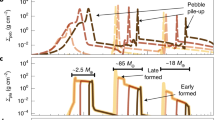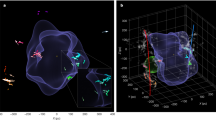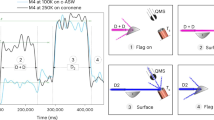Abstract
THERE now exists general agreement among astronomers that dust shells surrounding young stars are a relatively frequent occurrence, and attempts have been made to calculate some of the properties of such shells (see refs 1 and 2). One obvious possibility is that the dust absorbs the outgoing radiation from the star and re-emits it in the infrared, and this is perhaps the most acceptable explanation for a number of the infrared sources that have been detected in the Orion nebula and in other regions where star formation is suspected to be occurring. If the dust shell absorbs any radiation, then both its inner and outer surfaces will re-emit a certain proportion, though now at a different wavelength, so that some radiation will return to the central star—it is ‘warming its own back’ so to speak. It is interesting to ask how such a star will evolve when compared with the evolution of a normal pre-main-sequence star. A model for a contracting star which is receiving radiation from an external source has already been developed by the authors3 in connection with the evolution of Jupiter within the radiation field of the Sun, and here we apply this model to the situation just described.
This is a preview of subscription content, access via your institution
Access options
Subscribe to this journal
Receive 51 print issues and online access
$199.00 per year
only $3.90 per issue
Buy this article
- Purchase on Springer Link
- Instant access to full article PDF
Prices may be subject to local taxes which are calculated during checkout
Similar content being viewed by others
References
Kahn, F. D., Astr. Astrophys., 37, 149 (1974).
Silk, J., Proceedings of the Far Infra-Red Conference (edit. by Rowan-Robinson, G. M.) (Pergamon, Oxford, 1976).
Donnison, J. R., and Williams, I. P., Astrophys. Space Sci., 29, 387 (1974).
Eddington, A. S., The Internal Constitution of the Stars (Cambridge University Press, London, 1926).
Williams, I. P., Origin of the Solar System (Adam Hilger, London, 1975).
Chandrasekhar, S., An Introduction to the Study of Stellar Structure (University of Chicago Press, Chicago, 1939).
Low, F. J., Johnson, H. L., Kleinmann, D. E., Latham, A. S., and Geisel, S. L., Astrophys. J., 160, 531 (1970).
Wickramasinghe, N. C., and Nandy, K., Rep. Prog. Phys., 35, 159 (1972).
Weast, R. C., Handbook of Chemistry and Physics, B–188 (The Chemical Rubber Company Cleveland, 1968).
Author information
Authors and Affiliations
Rights and permissions
About this article
Cite this article
DONNISON, J., WILLIAMS, I. Effects of back warming in cocoon stars. Nature 261, 674–675 (1976). https://doi.org/10.1038/261674a0
Received:
Accepted:
Published:
Issue Date:
DOI: https://doi.org/10.1038/261674a0
This article is cited by
-
Backwarming due to circumstellar shells
Nature (1977)
Comments
By submitting a comment you agree to abide by our Terms and Community Guidelines. If you find something abusive or that does not comply with our terms or guidelines please flag it as inappropriate.



